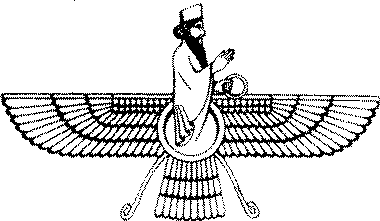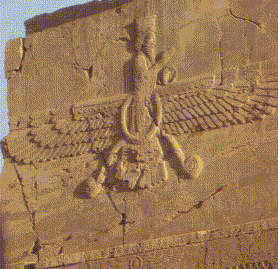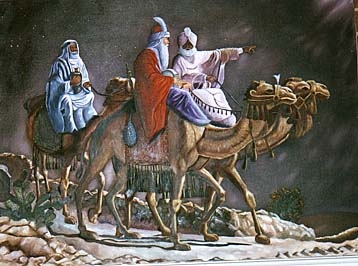 |
| (http://www-leland.stanford.edu/group/zoroastrians/images/farohar.gif) |
The phrase "Good Thoughts, Good Words, Good Deeds" represent the three pillars of the Zoroastrian Faith and sums up the beliefs and conduct of its followers. Zoroastrianism is the world's oldest revealed religion that believes in one God. It was founded by Zoroaster (Zarathustra) about a thousand years before the birth of Christ in ancient Persia (now Iran, where they are still persecuted). In the history of religions God has many names: Jehovah, Allah, etc. In Zoroastrianism God is called "Ahura Mazda" that means "Wise Lord". Other names of God in the Zoroastrian religion are: Omniscient (knows everything), Omnipotent (all powerful), Omnipresent (is everywhere), Inconceivable for humans, Unchanging, The Creator of life, The Source of all goodness and happiness. Therefore there are no images of God. Like in other major religions they believe that He created the world and pray to Him every day. They believe that if human beings choose to follow Him, that represents all good, evil will be defeated and the world will become a paradise.
 |
| Example of cuneiform Zoroastrian script. (http://www.avesta.org/avesta.html) |
The most important of Zoroastrian scriptures are the Gathas, or Hymns, composed by Zoroaster himself and are still kept in their original language. The oldest prayer in the world comes from the Zoroastrian faith from the Gathas and was kept through the oral traditions:
Yatha Ahu vairyo atha ratush, ashat chit hacha,
Vangheush dazda manangho, shyaothnanam angheush Mazdai;
Khshathremch Ahura a, yim dregubyo dadat vastarem.
"Just as God is to be chosen (by us), is the prophet in accordance with truth itself; the gift of good mind is for those who work hard, for God, in life. The power and glory of the creator are granted to those who give support to the poor and the needy."
 |
| Brazier with flame for Zoroastrian practices. (http://www.bbc.co.uk/religion/religions/zoroastrian/index.shtml) |
The temple where they go for worship is called Agiary or "Fire Temple". Inside there is a fire or hearth that symbolizes God´s Light or Wisdom and His purifying force. Being the one of the oldest religions, it was the first time that many common religious concepts where mentioned, specially: the concept of a supreme and inconceivable God, life after death, good and evil, judgment at death, heaven and hell and the end of the world. They believe that human beings can know God through His divine attributes: Good mind and good purpose (Vohu Manah), Truth and righteousness (Asha Vahishta), Holy devotion, serenity and loving kindness (Spenta Ameraiti), Power and just rule (Khashathra Vairya), Wholeness and health (Hauravatat), Long life and immortality (Ameretat). These attributes are represented as winged beings that remind of the archangels of the Christian Faith.
 |
| Faravahar from the ruins of Persepolis (http://www.stanford.edu/group/zoroastrians/) |
Zoroastrians have their own calendars and feasts and holy days. An important Zoroastrian festival is Naw-Ruz (New Year) and is shared by people from other faiths, such as the Muslims with Persian origin and the Bahá'ís. The Zoroastrian religion is so old that you can find their symbols in archeological places such as the ancient ruins of the city of Persepolis, and their sacred texts can be found written in cuneiform (wedged-like), that is one of the first known writing styles in the world and originally belonged to the Mesopotamian civilization. One of their sacred symbols is the Faravahar or Farohar, which is the winged symbol shown at the beginning of this story. The word Faravahar means "to choose" and it represents the freedom of choice that human beings have to follow good or evil.
 |
| Art by Mario Flores. (http://venus.soci.niu.edu/~sociclass/Mario/mario.html) |
Ever wonder who really where the three wise men from the east or magi that came to adore baby Jesus and how did they find Him? These magi where actually Zoroastrian priests, and they followed a prophecy made by Zoroaster nearly a thousand years before the birth of Christ:
"When I return, you will see a new star in the East--follow it and thou wilt find me there, cradled in straw."
Page created on 12/27/2008 11:19:02 AM
Last edited 1/9/2017 4:27:54 PM
